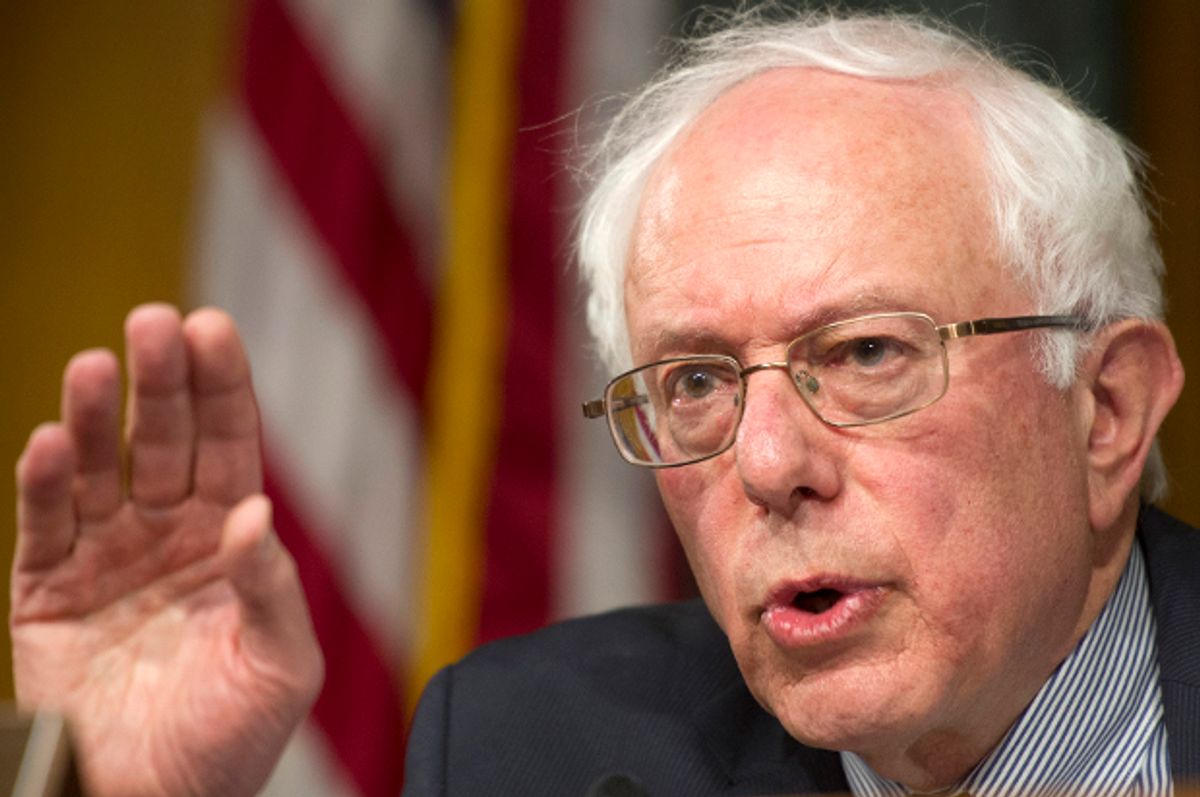Bernie Sanders held his first major presidential campaign event in Vermont yesterday afternoon after kicking off his 2016 bid with a delightfully offbeat Capitol Hill press conference. The tone of the coverage surrounding Sanders’ campaign doesn’t necessarily reflect it, but Vermont’s independent senator is actually pulling in a decent share of the Democratic vote. As of this writing, his support in national polling has climbed up into double digits, and the last few polls out of Iowa and New Hampshire put him at around 14 or 15 percent in those states. Of course, those numbers have to be measured against those of his chief rival, Hillary Clinton, who dominates both nationally and in the early states with more than 50 percent.
So Sanders is a long shot, but he’s not without a sizable bloc of support. In fact, when you crunch the numbers, Sanders is outperforming the combined support of several GOP presidential wannabes. The Bernie 2016 boomlet is clearly a bit puzzling to reporters, who don’t seem to know what to do with Sanders beyond treating him as a foil to Hillary, and so they default to doing nothing, even as every utterance of GOP candidates who are polling below 2 percent merits its own headline. There are clear double standards at play, and one of them pertains to how reporters cover a candidate who is unreservedly liberal versus how they cover “proudly conservative” Republicans. This dynamic is sometimes subtle, and it emerged during an interview Sanders gave with CNBC’s John Harwood.
Income inequality and the distribution of wealth are two topics Sanders hammers away at constantly, and during the interview with Harwood he brought up the fact that the top marginal tax rate for income during the 1950s was somewhere around 90 percent. Sanders’ comment took Harwood aback. “When you think about something like 90 percent, you don’t think that’s obviously too high?” he asked. “No,” Bernie shot back. Sanders’ endorsement of the Eisenhower-era tax structure also raised eyebrows at the New York Times, which observed that Sanders “doesn’t flinch over returning to the 90 percent personal income tax rates of the 1950s for top earners.” In these reactions you can easily spy an undercurrent of incredulity that a politician would enthusiastically advocate for rich people to pay more – much, much more – in taxes.
This is what happens after more than three decades of economic policymaking that has enshrined tax cuts as the greatest good one can strive for. For Republicans, the policy is tax cuts everywhere and always and most especially for the rich. For Democrats, it’s tax cuts for the middle class while the wealthy, who benefit disproportionately from a tax structure that is “barely progressive,” are asked only to “pay a little more.” We’ve become so accustomed to historically low rates of taxation for the wealthy that when someone like Sanders comes along and says the rich can and should pay a far higher rate, people assume he’s out to lunch.
But is a 90 percent top rate “obviously too high”? Is it something one should instinctively “flinch” at? Not really, says Bryce Covert:
Last year, economists found that the point at which the top tax rate is high enough to maximize government revenues but not so high that it discourages the rich from trying to earn more is quite high: about 95 percent for the 1 percent. History bears that out. Economists have pointed out that post-war American growth has been higher during periods with much higher top marginal tax rates and lower when tax rates were substantially lower. When the top rate was more than 90 percent in the 50s, economic growth averaged more than 4 percent a year. But recently when the top rate has been closer to 35 percent, growth has been less than 2 percent a year on average.
The flip side to the dynamic is that while reporters and pundits raise their eyebrows at the notion of dramatically increasing the tax burden on the wealthy, absurd and irresponsible tax cuts for top earners are now just assumed to be a given when it comes to Republican policymaking. Several current Republican candidates for the presidency have laid out plans that would eliminate capital gains taxes and the estate tax while cutting the top income tax rate. They propose to offset the costs of these cuts by eliminating certain deductions, but preserving the ones that benefit the rich the most, like the mortgage interest deduction and the deduction for charitable giving.
The thrust of GOP policymaking is to redirect an even greater share of the nation’s wealth to the already engorged few sitting at the top of the income ladder. Sanders is proposing instead that we funnel some of that wealth away from the rich and toward the middle class. And while we’re supposed to “flinch” at a high rate of taxation for income, a zero percent rate on investments is taken in stride.

Shares